 Technology peripherals
Technology peripherals
 AI
AI
 What should I do if AI can't understand 'he, she, it'? Verbs have become a new breakthrough. When the robot hears butter, it knows how to pick up a knife and fork.
What should I do if AI can't understand 'he, she, it'? Verbs have become a new breakthrough. When the robot hears butter, it knows how to pick up a knife and fork.
What should I do if AI can't understand 'he, she, it'? Verbs have become a new breakthrough. When the robot hears butter, it knows how to pick up a knife and fork.
When giving instructions to AI, do you always feel that communicating with people is different?
Yes, AI can understand some specific human instructions, such as:
Help move a chair from the restaurant.
But if it is replaced by vague instructions with only pronouns (he/she/it/this/that/thing...) and verbs, the AI will be confused:
Help find someone who can step in s things.
Now, some researchers have finally come up with a new way to deal with it: wouldn’t it be enough to let AI learn to understand verbs?
The verb itself is bound to some specific nouns. For example, the action of "spreading butter" is definitely inseparable from nouns such as "knife" and "fork".
Only need to match them, without noun instructions such as "knife and fork", AI can also accurately find the target object:
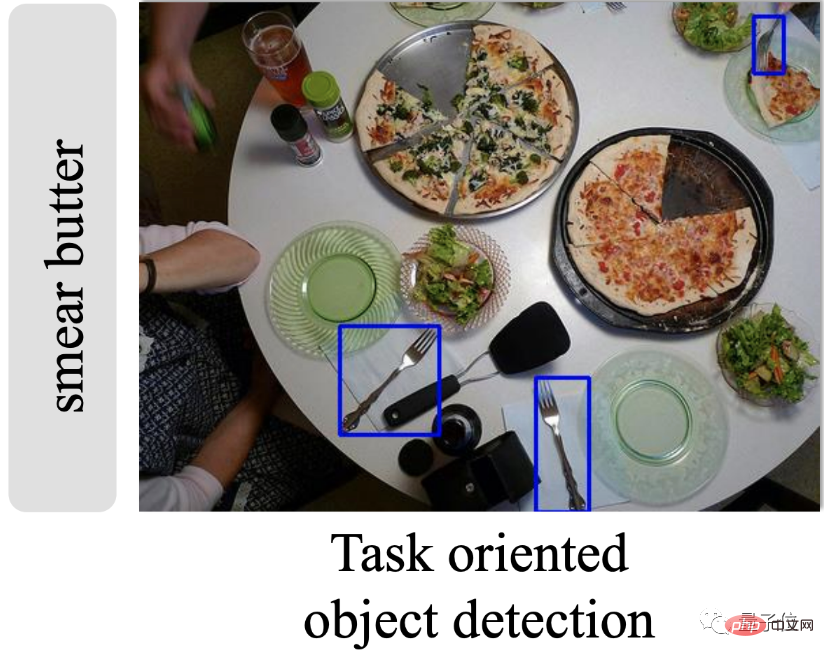
Currently, This paper has been officially included in NeurIPS 2022, and the related model has also been open source:

So how does it train AI to understand verbs?
Covering nouns allows AI to "find objects by looking at pictures"
The paper proposes a framework called TOIST.
TOIST stands for "Task Oriented Instance Segmentation Transformer" (Task Oriented Instance Segmentation Transformer), which is a new instance segmentation solution based on Transformer.
Instance segmentation is different from the "full image cutting" of semantic segmentation. It also has the characteristics of target detection. For example, the following figure uses the noun "hatchback car" to directly find the corresponding object. :
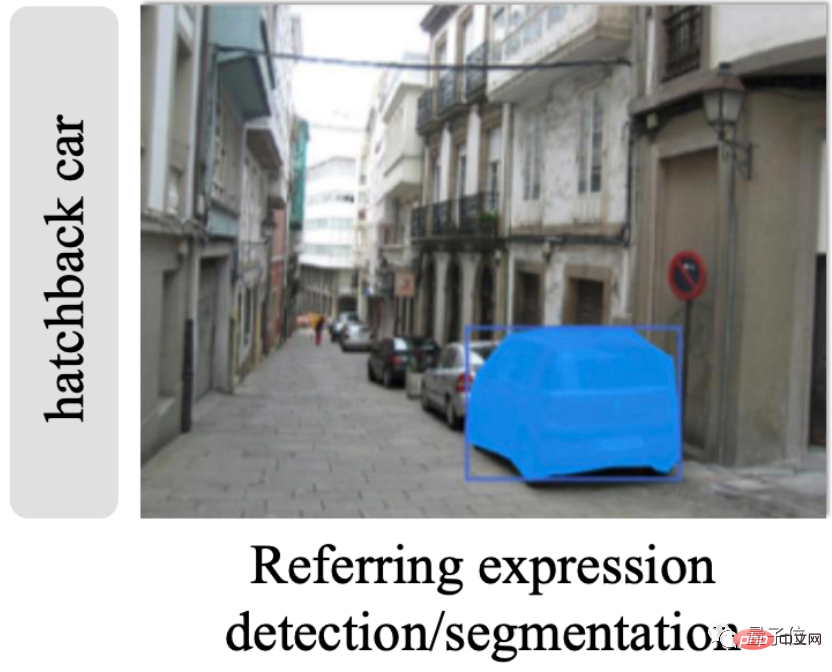
Previously, instance segmentation models were usually divided into "two steps", the first step is to detect possible targets, and the second step is to sort the possible targets. , predict the most likely outcome.
But unlike this approach, the TOIST framework directly adopts an entire Transformer architecture, in which the self-attention mechanism in the decoder can establish the preference relationship between candidate targets.
The TOIST framework is divided into three parts.
Among them, the multi-modal encoder (brown part) is responsible for extracting feature markers, and the Transformer encoder (green part) is responsible for aggregating the features of the two modalities, and based on the Transformer decoder (blue part) attention mechanism to predict the most appropriate target.
Subsequently, the paper proposed a new noun-pronoun distillation method (noun-pronoun distillation) to train the model.
Specifically, based on the framework of knowledge distillation (teacher-student model in the picture above), AI is trained to "guess" noun prototypes based on context in an unsupervised learning manner.
For example, the original instance segmentation task is "digging holes with a skateboard", but when training the model, the noun "skateboard" will be replaced by the pronoun "something":
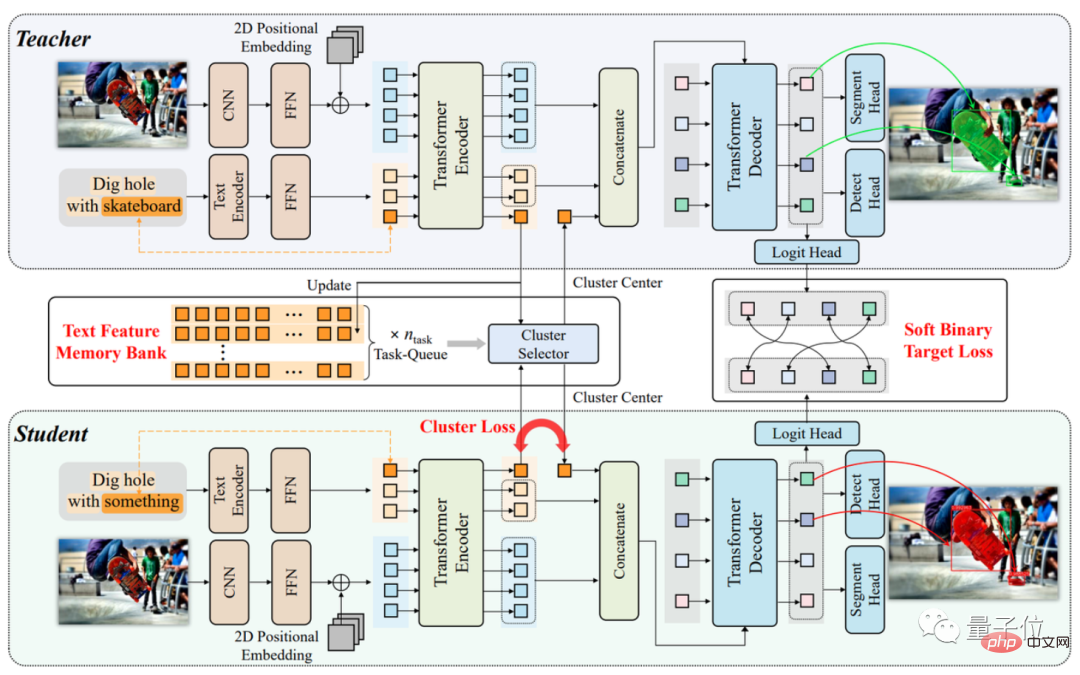
In this way, the AI can guess the correct noun out of thin air even if it does not know the noun, and segment the correct target in the picture:
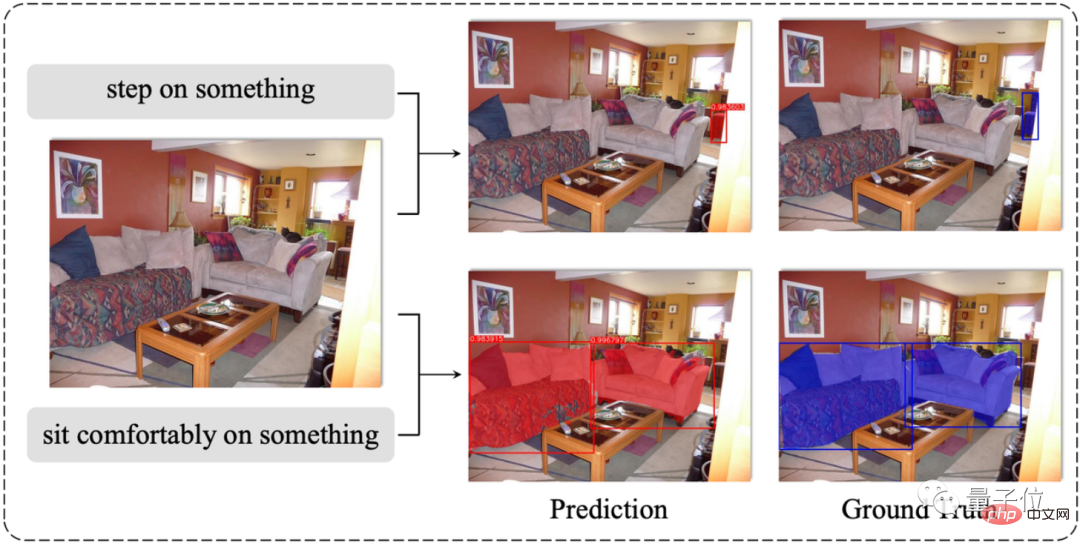
How does this segmentation effect perform in actual cases?
Target detection accuracy increased by 10.9%
The paper tested TOIST on the large-scale task data set COCO-Tasks.
The evaluation method uses mAP (mean Average Precision), which is common in visual tasks such as target detection.
To put it simply, TOIST performs better than the previous instance segmentation and target detection model SOTA model, and with the addition of the noun-pronoun distillation method, the "enhanced version" TOIST performs better than TOIST. Floors.
In the target detection task, compared with the current best Yolo GGNN, the "enhanced version" TOIST's decision box accuracy mAP increased by 10.9%. In the instance segmentation task, the mask accuracy was higher than Mask- RCNN GGNN is 6.6% higher.

As for the proposed noun-pronoun distillation method, compared with the original version of TOIST, the accuracy on the instance segmentation task has been improved by 2.8% and 3.8% respectively.
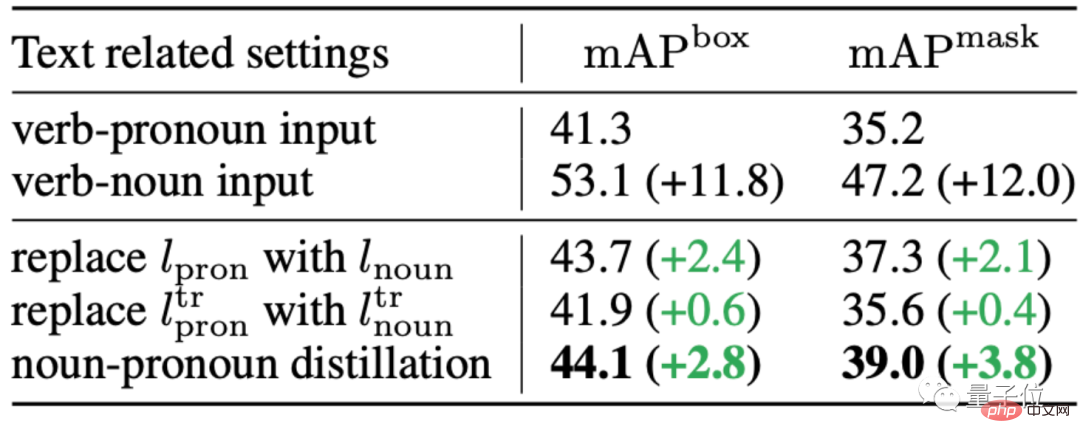
#In terms of case performance, the model effect is also very close to the actual segmentation true value.
For example, in Figure (d), the algorithm even recognized that the beer bottle cap can be opened using a table. It can be said that the understanding ability is perfect:

For doing this Regarding the original intention of the research, the author responded:
Our laboratory is actually responsible for researching robots, but during daily surveys, we found that users sometimes prefer to describe "needs" to robots. Rather than directly telling the robot what to do.
In other words, AI algorithms are used to make the robot "think one more step" instead of just being an assistant that follows orders.
Introduction to the author
The authors of this paper come from Tsinghua University Intelligent Industry Research Institute (AIR), Peking University and Intel Research Institute. Zhang Yaqin, dean of AIR, is also one of the authors.

Li Pengfei, the first author of the paper, is a doctoral candidate at the Institute of Intelligent Industry of Tsinghua University. He graduated from the University of Chinese Academy of Sciences with a bachelor's degree. His research interests include autonomous driving and computer vision.
The corresponding author, Zhao Hao, is an incoming Assistant Professor at the Intelligent Industry Research Institute of Tsinghua University, a research scientist at Intel China Research Institute, and a joint postdoctoral fellow at Peking University. He graduated from Tsinghua University in electronic engineering. Department, research interests are in the direction of robotics and computer vision.

Paper address: https://arxiv.org/abs/2210.10775
Project address: https://github.com/AIR-DISCOVER/ TOIST
The above is the detailed content of What should I do if AI can't understand 'he, she, it'? Verbs have become a new breakthrough. When the robot hears butter, it knows how to pick up a knife and fork.. For more information, please follow other related articles on the PHP Chinese website!

Hot AI Tools

Undresser.AI Undress
AI-powered app for creating realistic nude photos

AI Clothes Remover
Online AI tool for removing clothes from photos.

Undress AI Tool
Undress images for free

Clothoff.io
AI clothes remover

Video Face Swap
Swap faces in any video effortlessly with our completely free AI face swap tool!

Hot Article

Hot Tools

Notepad++7.3.1
Easy-to-use and free code editor

SublimeText3 Chinese version
Chinese version, very easy to use

Zend Studio 13.0.1
Powerful PHP integrated development environment

Dreamweaver CS6
Visual web development tools

SublimeText3 Mac version
God-level code editing software (SublimeText3)

Hot Topics
 How to use the chrono library in C?
Apr 28, 2025 pm 10:18 PM
How to use the chrono library in C?
Apr 28, 2025 pm 10:18 PM
Using the chrono library in C can allow you to control time and time intervals more accurately. Let's explore the charm of this library. C's chrono library is part of the standard library, which provides a modern way to deal with time and time intervals. For programmers who have suffered from time.h and ctime, chrono is undoubtedly a boon. It not only improves the readability and maintainability of the code, but also provides higher accuracy and flexibility. Let's start with the basics. The chrono library mainly includes the following key components: std::chrono::system_clock: represents the system clock, used to obtain the current time. std::chron
 Decryption Gate.io Strategy Upgrade: How to Redefine Crypto Asset Management in MeMebox 2.0?
Apr 28, 2025 pm 03:33 PM
Decryption Gate.io Strategy Upgrade: How to Redefine Crypto Asset Management in MeMebox 2.0?
Apr 28, 2025 pm 03:33 PM
MeMebox 2.0 redefines crypto asset management through innovative architecture and performance breakthroughs. 1) It solves three major pain points: asset silos, income decay and paradox of security and convenience. 2) Through intelligent asset hubs, dynamic risk management and return enhancement engines, cross-chain transfer speed, average yield rate and security incident response speed are improved. 3) Provide users with asset visualization, policy automation and governance integration, realizing user value reconstruction. 4) Through ecological collaboration and compliance innovation, the overall effectiveness of the platform has been enhanced. 5) In the future, smart contract insurance pools, forecast market integration and AI-driven asset allocation will be launched to continue to lead the development of the industry.
 Recommended reliable digital currency trading platforms. Top 10 digital currency exchanges in the world. 2025
Apr 28, 2025 pm 04:30 PM
Recommended reliable digital currency trading platforms. Top 10 digital currency exchanges in the world. 2025
Apr 28, 2025 pm 04:30 PM
Recommended reliable digital currency trading platforms: 1. OKX, 2. Binance, 3. Coinbase, 4. Kraken, 5. Huobi, 6. KuCoin, 7. Bitfinex, 8. Gemini, 9. Bitstamp, 10. Poloniex, these platforms are known for their security, user experience and diverse functions, suitable for users at different levels of digital currency transactions
 Which of the top ten currency trading platforms in the world are the latest version of the top ten currency trading platforms
Apr 28, 2025 pm 08:09 PM
Which of the top ten currency trading platforms in the world are the latest version of the top ten currency trading platforms
Apr 28, 2025 pm 08:09 PM
The top ten cryptocurrency trading platforms in the world include Binance, OKX, Gate.io, Coinbase, Kraken, Huobi Global, Bitfinex, Bittrex, KuCoin and Poloniex, all of which provide a variety of trading methods and powerful security measures.
 What are the top ten virtual currency trading apps? The latest digital currency exchange rankings
Apr 28, 2025 pm 08:03 PM
What are the top ten virtual currency trading apps? The latest digital currency exchange rankings
Apr 28, 2025 pm 08:03 PM
The top ten digital currency exchanges such as Binance, OKX, gate.io have improved their systems, efficient diversified transactions and strict security measures.
 How much is Bitcoin worth
Apr 28, 2025 pm 07:42 PM
How much is Bitcoin worth
Apr 28, 2025 pm 07:42 PM
Bitcoin’s price ranges from $20,000 to $30,000. 1. Bitcoin’s price has fluctuated dramatically since 2009, reaching nearly $20,000 in 2017 and nearly $60,000 in 2021. 2. Prices are affected by factors such as market demand, supply, and macroeconomic environment. 3. Get real-time prices through exchanges, mobile apps and websites. 4. Bitcoin price is highly volatile, driven by market sentiment and external factors. 5. It has a certain relationship with traditional financial markets and is affected by global stock markets, the strength of the US dollar, etc. 6. The long-term trend is bullish, but risks need to be assessed with caution.
 Which of the top ten currency trading platforms in the world are among the top ten currency trading platforms in 2025
Apr 28, 2025 pm 08:12 PM
Which of the top ten currency trading platforms in the world are among the top ten currency trading platforms in 2025
Apr 28, 2025 pm 08:12 PM
The top ten cryptocurrency exchanges in the world in 2025 include Binance, OKX, Gate.io, Coinbase, Kraken, Huobi, Bitfinex, KuCoin, Bittrex and Poloniex, all of which are known for their high trading volume and security.
 Bitcoin price today
Apr 28, 2025 pm 07:39 PM
Bitcoin price today
Apr 28, 2025 pm 07:39 PM
Bitcoin’s price fluctuations today are affected by many factors such as macroeconomics, policies, and market sentiment. Investors need to pay attention to technical and fundamental analysis to make informed decisions.





